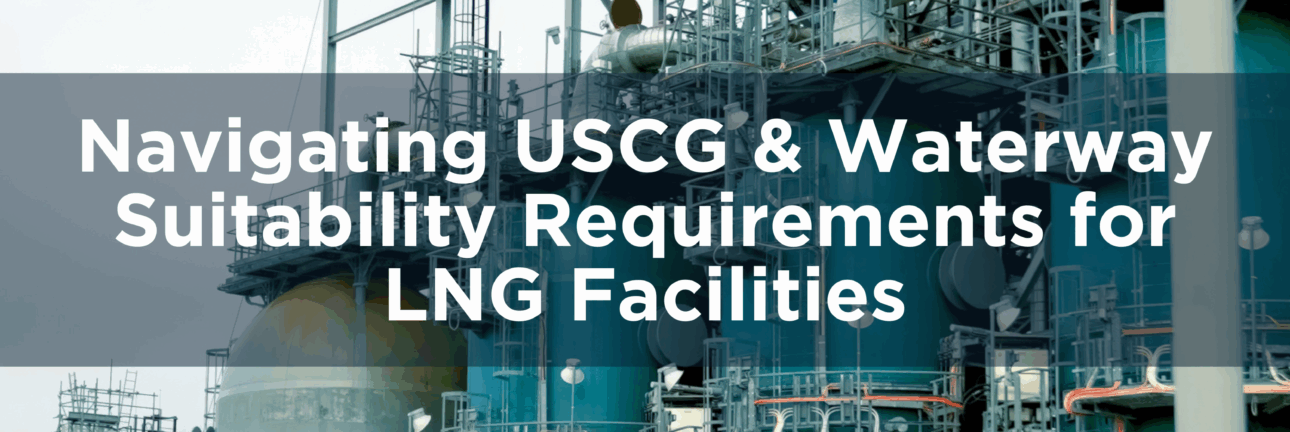Navigating USCG and Waterway Suitability Requirements for LNG Facilities

The regulatory landscape for liquefied natural gas (LNG) facilities is as complex as the operations themselves. Among the first layers of oversight are the requirements set by the U.S. Coast Guard (USCG) and the crucial Waterway Suitability Assessment (WSA) process, both of which set the stage for safe operations.
In this installment of our LNG and maritime safety series, Steve Calabrese explains how to approach USCG requirements. He discusses common pitfalls during approval and the importance of WSAs in shaping operational safety measures.
USCG Requirements
Q: How do you navigate the U.S. Coast Guard’s requirements for LNG facility operations, and what are common pitfalls during approval processes?
A: Navigating the U.S. Coast Guard’s regulatory requirements begins with a solid understanding of the framework under 33 CFR Part 127, which governs LNG waterfront facilities. At its core, compliance is built around the Letter of Intent (LOI), the Preliminary and Follow-on Waterway Suitability Assessments (WSAs), and ultimately the issuance of a Letter of Recommendation (LOR) from the USCG. In addition to the CFR, the Coast Guard has issued policy letters and Navigation and Vessel Inspection Circulars (NVICs) that provide essential guidance for LNG projects. These include policy letters on LNG bunkering and ship-to-ship transfers, NVIC 01-2011 on LNG and LPG operations, and other guidance from the Office of Operating and Environmental Standards (CG-OES). This guidance clarifies expectations for hazard analysis, operational risk assessments, and stakeholder engagement. Together, these regulations, policies, and guidance documents form the backbone of LNG facility approval and oversight.
What makes these requirements manageable in practice is the foundation developed through past project experience. Having supported multiple LNG export, import, and bunkering projects through the regulatory cycle, it’s been possible to learn how to translate regulations into actionable strategies for clients. For example, while the regulations outline what needs to be submitted, successful navigation often hinges on how risks are characterized and how thoroughly stakeholders are engaged. It also depends on how effectively technical analyses—such as navigation simulations and hazard modeling—are presented. Past experience allows anticipation of Coast Guard concerns and proactive integration into the project design and approval process.
One of the most common pitfalls encountered is underestimating the importance of early and transparent stakeholder engagement. Local pilot associations, emergency management agencies, and neighboring industries all have a role in the WSA process. Overlooking their concerns can slow or even derail approval. Another frequent challenge is when developers treat the WSA as a one-time regulatory submission rather than a living risk management tool. The Coast Guard expects to see not just analysis but also a clear path for how identified risks will be managed operationally. Finally, some projects run into delays because their emergency response planning is not fully integrated with local authorities, leaving gaps in how a release or incident would be communicated and mitigated.
By pairing a clear understanding of the regulations, policy guidance, and NVICs with lessons learned from past projects, it is possible to guide clients through the Coast Guard approval process efficiently. This approach also strengthens their long-term safety and operational readiness.
Waterway Suitability Assessments
Q: What are the main components of a Waterway Suitability Assessment (WSA), and how do they inform operational safety measures?
A: The main components of a WSA include port characterization and facility and carrier characterization. Port characterization documents the existing waterway conditions, vessel traffic patterns, navigational constraints, and port infrastructure. This establishes the baseline against which LNG operations will be introduced. Facility and carrier characterization describes the LNG terminal or bunkering facility, vessel dimensions, transfer operations, and frequency of movements. Together, these form the foundation for assessing how LNG operations will integrate into the existing marine environment.
The third and fourth components are the risk assessments and risk management strategies. Using hazard identification workshops, quantitative risk assessments, navigation simulations, and stakeholder input, the WSA identifies credible hazards such as vessel collisions, groundings, or simultaneous operations with other traffic. Risk management strategies are then developed to address those hazards. This can be done through operational controls, exclusion zones, scheduling adjustments, or coordination with Vessel Traffic Service (VTS).
Finally, the WSA includes an assessment of resource needs for maritime safety, security, and emergency response. This examines tug availability, firefighting capabilities, law enforcement presence, and coordination with local emergency management agencies. These findings directly inform Memoranda of Understanding (MOUs) and cost-sharing agreements. They ensure that the resources needed to manage LNG risks are identified and committed prior to operation.
Each of these WSA components feeds directly into operational safety measures. For example, dispersion modeling and exclusion zone analysis determine how close other vessels or the public can safely be during transfer. Navigation simulations influence pilotage requirements and escort tug availability. Resource assessments shape the level of preparedness required from fire departments, port authorities, and neighboring industry. In this way, the WSA is not just a regulatory submission but a practical blueprint for how LNG operations can be conducted safely and securely within a given waterway.
Closing Thoughts
Meeting USCG requirements and preparing a comprehensive WSA are critical first steps for any LNG project. With the right expertise, these processes not only ensure compliance but also strengthen operational safety.
To continue the conversation, meet Steve at the 21st Americas LNG Summit & Exhibition in Lake Charles, October 19–21, 2025.
